It wasn't all that long ago that selling digital products online required a lot of technical know-how. Today, anyone can set up a store and sell ebooks, courses and memberships, or even physical products.
There are numerous platforms out there to help people get started with selling online, and Payhip is one of them.
Is Payhip worth using as an online creator? Let's explore the platform and find out.
What is Payhip?
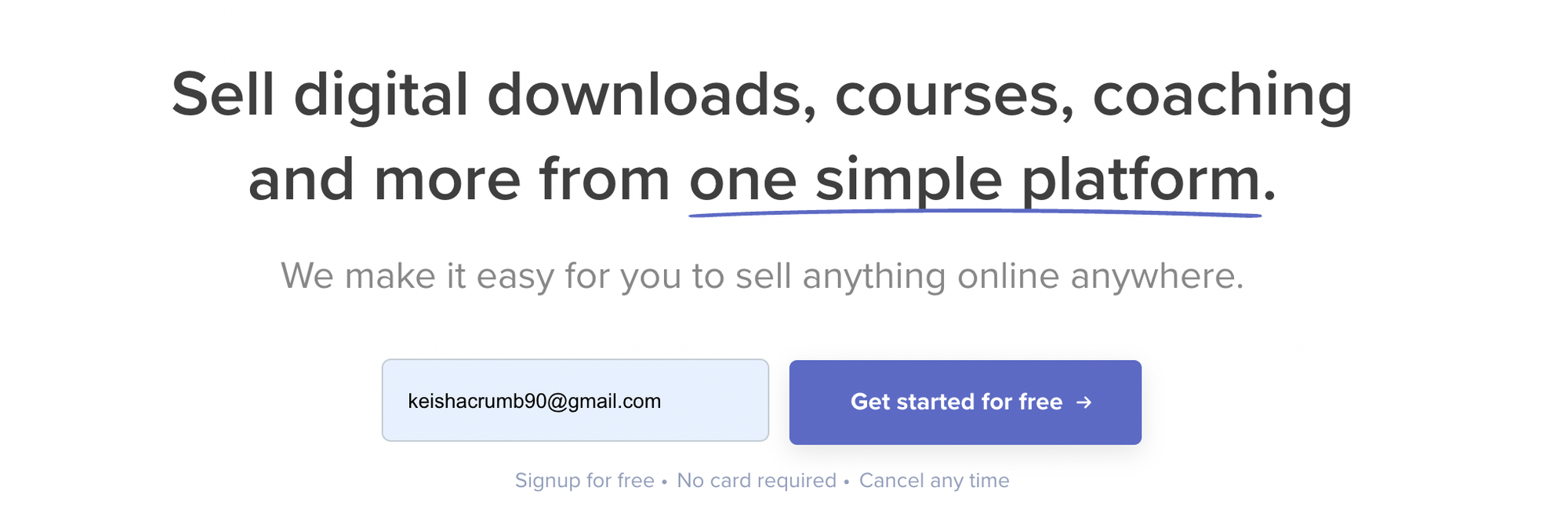
Payhip was one of the earliest entries into the world of digital commerce. It's a UK-based company that was set up in 2011. The founders bootstrapped the company and it quickly found a passionate user base among content creators and online coaches who wanted an easy, reliable way of selling their products online.
Over a decade later, the core of the platform remains the same. It offers easy ways to sell both digital and physical products.
What is Payhip Used For?
Payhip's target audience is anyone who wants to sell online. The platform markets itself as a simple way to get started with ecommerce, while promising to be able to grow and scale as your business evolves.
Today, there are dozens of SaaS platforms targeting specific niches, such as course creators, podcasters, or social media influencers. Payhip can cater to those individuals, but the platform works best as a fully-featured online store.
How Does Payhip Work?
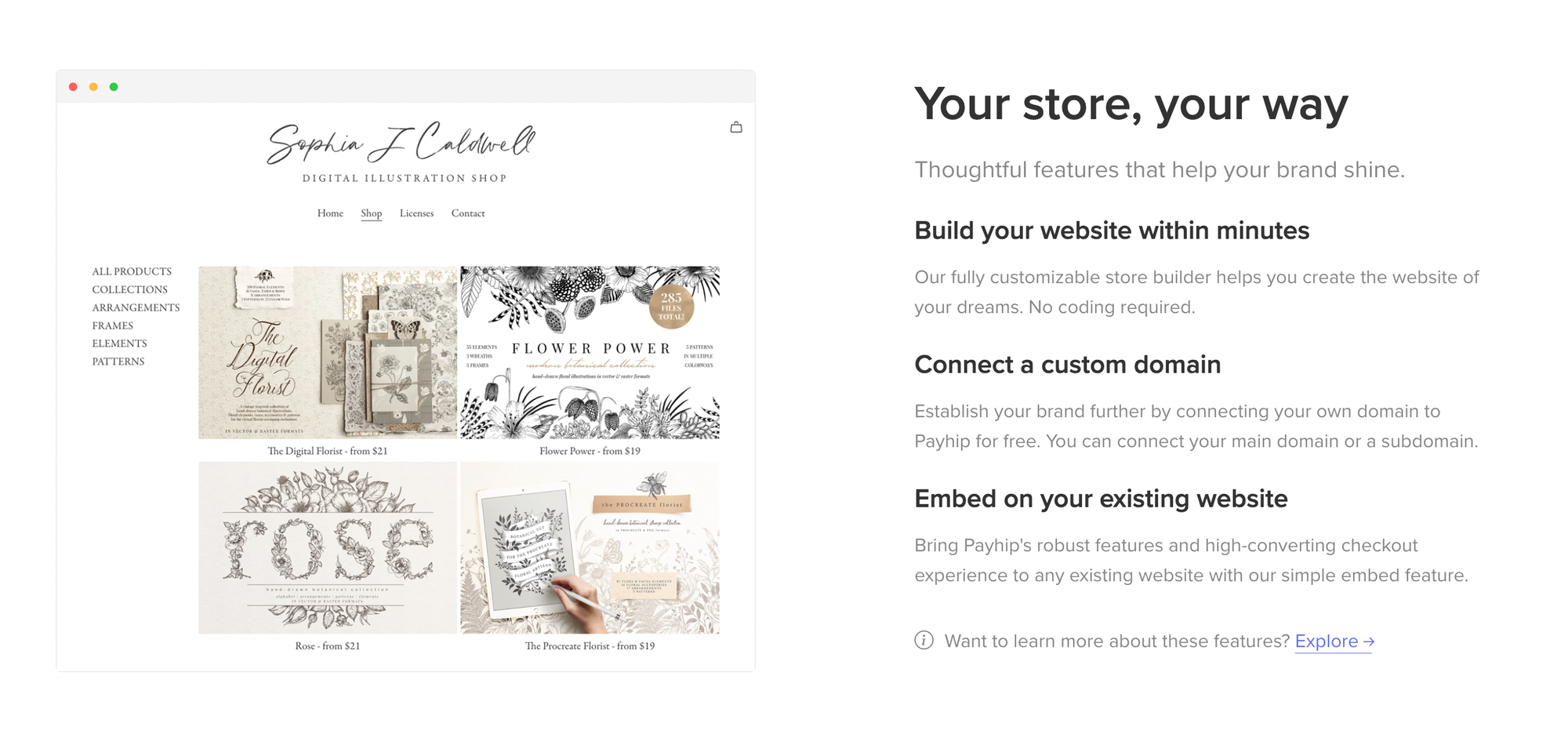
Selling on Payhip
As a seller, it's easy to get started with Payhip. You can sign up for the platform for free and without having to provide any payment information. All you'll be asked for on registration is your name and email address.
After registration, you'll be asked to provide a name for your store. This will be used as part of your store's address in the format https://payhip.com/STORENAME, so if you're not planning on using a custom domain when you launch your store, choose the name carefully.
Custom domains are available to all users, and Payhip doesn't charge you anything for configuring one, although you will have to purchase the domain from a third party such as GoDaddy or FX Domains. The annual fee for a domain name isn't particularly expensive, however, and they make your store appear far more professional, so it's worth spending the money if you're serious about running an online store.
Once you've picked a name for your store, you'll be taken to a setup page that asks you to do three things:
- Add your first product
- Set up your payment options
- Customize the layout of your store
You will then be asked to upload your product. Payhip supports several products, including:
- Digital products (e.g. ebooks or software)
- Courses
- Memberships
- Physical products
- Coaching services
You can also bundle multiple products together to sell for one price. Once you have chosen your product type, you simply upload it, enter a title and price, upload a cover image, and choose the visibility of your product.

Payhip also offers some useful extra settings under Advanced options on the product creation page to help you limit the number of times a product can be sold, generate license keys (for software products), manage product variations, and set tax rates on a per-product basis.
With Payhip, you can also configure the look and feel of your store. The default store theme is a minimalistic one with a white background and black text. It's quite neat and easy to use, but may not match your brand. To customize your store, click on the banner that reminds you to complete your store setup, and choose the Customize your store option. This will take you to the store builder, where you can create product collections, add blog pages to your store, and change the color scheme.
There's now just one thing left to do to get your store up and running: configure the payment options. Payhip works with both PayPal and Stripe, giving your prospective customers plenty of payment methods to choose from.
Payhip Features and Tools
Payhip's ecommerce features are quite comprehensive. It supports most common product types and has an intuitive store builder. It also offers some other useful features, including:
- Affiliate programs
- Flexible pricing with bundles, discounts and subscriptions
- Built-in blogging features
- Integrate the Payhip checkout with your existing website
- Tools for handling UK and EU VAT
- Cross-selling and other marketing features
- Built-in analytics
- Third-party integrations for email marketing
However, the platform has some limitations. For one, the customization options are quite limited. You can change the color scheme and have a reasonable amount of control over how products are grouped together, but there aren't many options for customizing the layout of your store. Some other store platforms, such as WooCommerce and Shopify offer a far higher degree of control over how the store looks and feels. If you want a lot of control over your store's branding, you might find Payhip disappointing.
Contacting Payhip: Customer Service Avenues
When you join Payhip, you'll be ushered through a simple onboarding process and sent some links to introductory videos to help you learn the platform. If you run into any problems, you can contact support by email. To the company's credit, their contact details are easy to find, being displayed prominently on the welcome banner, and as a link in the footer on all pages of the website. Still, there is no option to call Payhip, meaning that you have to rely on email support, which is not ideal when you're running a business through the platform.
Unfortunately, customer feedback is mixed, with a 3.1 out of 5-star review on Trust Pilot. Many customers report slow page loading times and other minor issues with the platform.
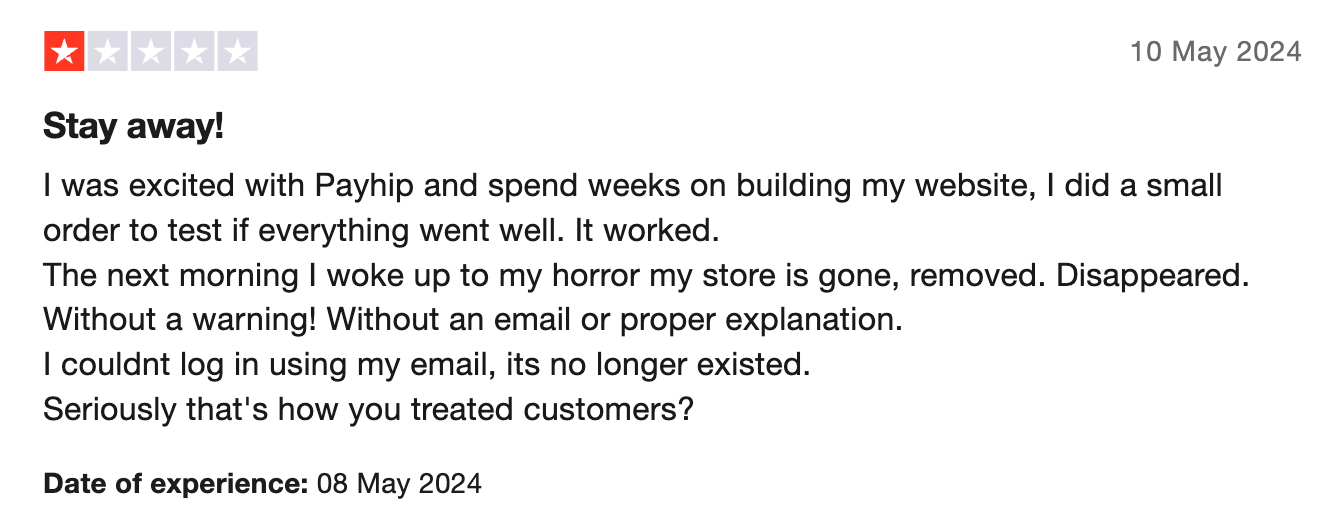

More worryingly, there are reports of creators investing time to set up a store or create a course, then having their store removed without warning. It's possible some of those users violated the terms of service, but the lack of communication from the support team is still cause for concern. Then, there are complaints of the lack of customer service and not being paid out funds.
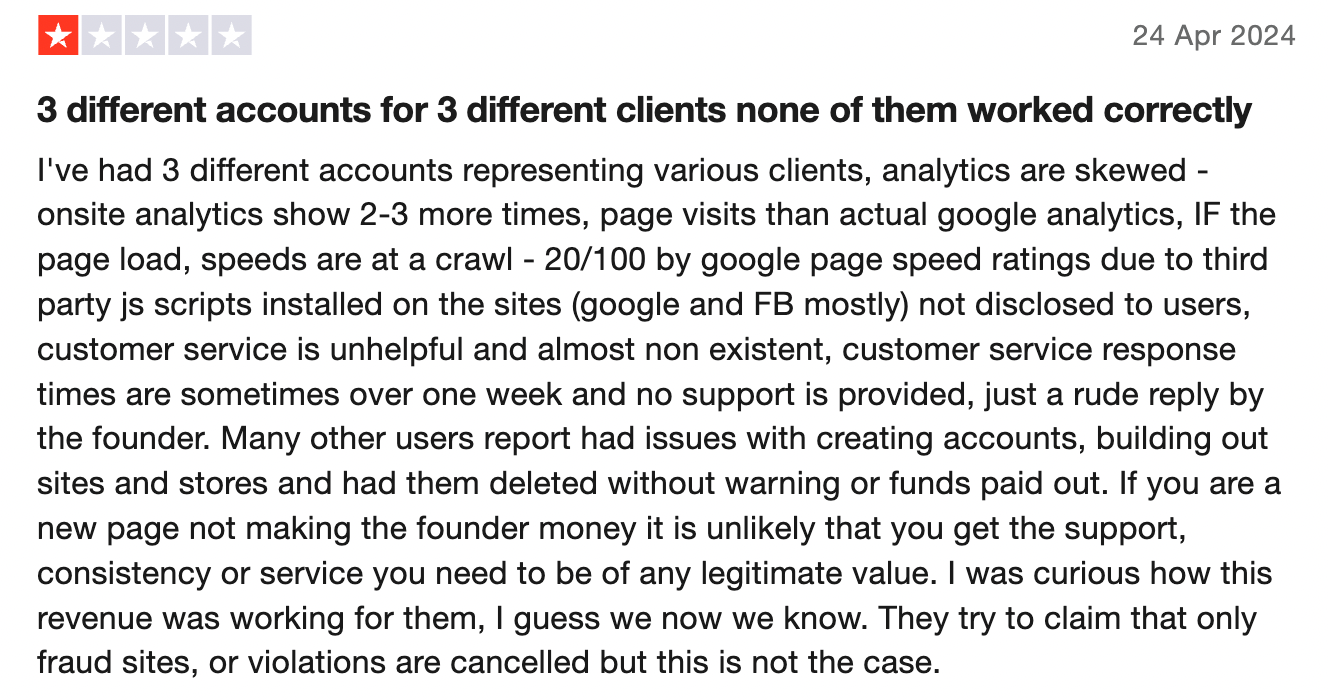
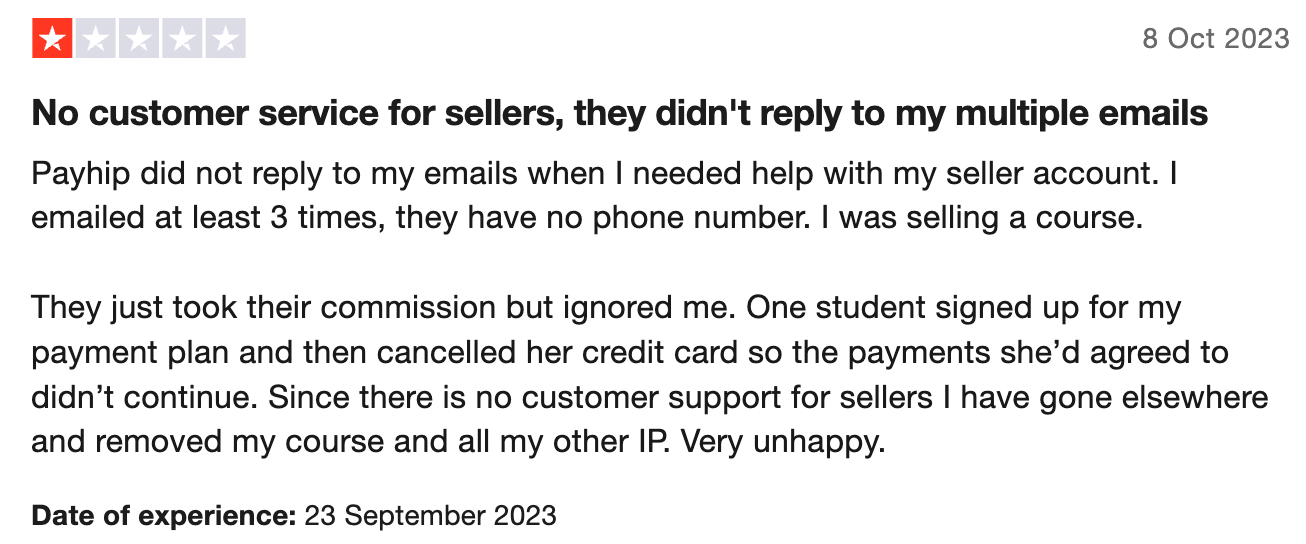
How Much Does Payhip Cost?
Payhip is in the minority in the ecommerce space in that it offers a free forever tier. Users on this tier can access all of the platform's features and upload an unlimited number of products. The platform then takes a 5% transaction fee on all sales made (note: this is on top of any fees charged by the payment processor).
This free tier is ideal for smaller creators and those who are just testing the waters with their online store. If you start selling a lot of products, you may wish to upgrade. There are two premium tiers:
- Payhip Plus: Costs $29/month, with a 2% transaction fee
- Payhip Pro: Costs $99/month, with no transaction fee
In addition to the plans listed above, Payhip offers native video streaming, which costs $5 a month for up to 16 hours of video being uploaded. This is an optional feature, and if you choose not to use it you can still embed video from third-party platforms such as Vimeo or YouTube. If you need to upload a lot of video files or expect to have extremely high bandwidth use, you can contact the support team to negotiate a bespoke plan.
Payhip Alternatives
Payhip is a good option for newcomers to the world of ecommerce. It handles issues such as shipping fees and taxes very well, and requires no technical knowledge to get started, especially if you're happy using a Payhip address for your store. If you want to use a custom domain, you'll need to configure that, but the documentation for doing this is clear and easy to follow.
Unfortunately, the platform's limited customization options and slow performance is not ideal for those looking to grow their businesses to high levels of success. Fortunately, there are plenty of alternatives out there:
Gumroad
Gumroad is a popular platform with digital content creators. On paper, Gumroad costs more than Payhip, with the platform taking a higher commission out of any sales. It also has even more limited customization options. However, it offers some nice extra features, including a busy marketplace and free online marketing features. If you don't have a lot of reach to market directly to your target audience and want the discoverability that comes with being part of a large, popular marketplace on a trusted platform, choosing Gumroad could work out well for you.
Shopify
Shopify is primarily designed for entrepreneurs who want to sell physical products or do dropshipping. It can be used for digital downloads or courses but requires plugins for this. Shopify is far more expensive than Payhip and while it's easy to get started with, the learning curve for customizing the store is steep.
🥇Whop - The Ultimate Payhip Alternative

Whop is a versatile social commerce platform that offers all the core features of Payhip, along with more modern tools for community building and subscriptions. The platform also offers a marketplace for those who wish to use it, but the core of the service is its Hub feature.
Creators can build a Whop Hub that they invite their followers to join. Hubs can be free, or you can charge for a membership. Once you have a Hub set up, you can then add products to it, and decide whether those products are things anyone can buy, or that require a certain level of community access.
Like Payhip, Whop is free to join and there are no monthly fees. There's a 3% commission on all sales, and the platform handles payments for you, making it quite an affordable option even for those who have fairly high sales volume with lower fees than Payhip (and no charge for live video in Whop hubs!).
Because Whop was built with digital creators in mind, it offers unprecedented flexibility. You can sell almost anything, including:
- Ebooks and videos
- Courses (using the built-in course creator)
- Communities
- Access to Discord or Telegram groups
- Software
- 3D printer schematics
- Website themes
- Scripts
- Tradingview signals
You can do all of this in your Whop Hub. This keeps all of your customers in one place, for one low fee. If you're a creator, why not create a hub where your customers can chat, share advice in forums, take a course, access ebooks, watch a live webinar in the hub, and more?
The platform also has built-in analytics features, and collects email addresses and other details from your customers. If you have an existing mailing list or CRM platform, it's easy to export the data from Whop and use it in that platform. Also, Whop has 24/7 customer service, so you can get the help you need when you need it, not days later.
Getting started with Whop is easy. Why not sign up today, create your first Hub, and see firsthand why so many online entrepreneurs have joined the Whop community?





